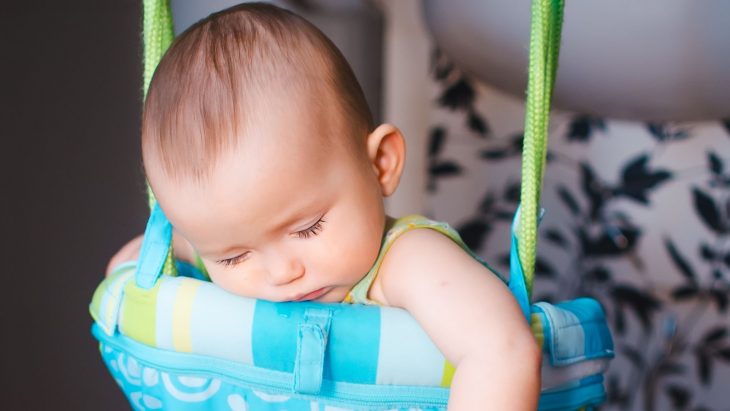A baby jumper is a handy device to have around, especially once your baby is old enough to use it. But how long do babies use jumpers? Are they safe for babies to use everyday? These questions are important to ask and we’re ready with an answer. Join us as we explore how to safely utilize a baby jumper and at what age it might be time to pack the jumper away.
What Is a Baby Jumper?
A baby jumper can be classified as a “toy”. It keeps your baby contained in a harness that allows them to “jump” on the balls of their feet while being suspended in the air. There are several kinds of jumpers including those that can be used in a doorway and those that stand alone. These devices have been utilized by many parents of young babies. But questions have surfaced about the safety of them, especially in light of recent baby jumper recalls and fatalities.
In order to best keep your child safe, we recommend that you become familiar with the age and weight limit of jumpers. It’s important to adhere to them closely.
We also recommend that you follow certain guidelines for when the baby jumper is in use. This keeps your child free from danger while they utilize this fun and engaging toy at home.
Baby Jumper Age Limit
Wondering what age can a baby go in a Jumperoo or a similar jumper?
When it comes to baby jumpers, there isn’t really a set “age limit”, in most cases. While you’ll always want to eyeball the safety specifications before purchasing your next baby jumper, most baby jumpers come with height and weight limits rather than age limits. This is likely because children develop at different rates. The age at which your baby is a certain weight could be radically different from another baby of the same age.
Therefore, it is far more important to know the height and weight requirements of your specific baby jumper. But also observe the physical signs that it may be time to stop using a baby jumper. Even before your baby reaches the height and weight limits set forth by the manufacturer.
Baby Jumper Weight Limit
Similar to known weight limits for baby swings, most baby jumpers will come with a height and weight limit rather than an age limit. These limits will vary from brand to brand and even from model to model. But most baby jumpers will require you to stop using the device once your baby is between 25-30 pounds, or around 32 inches tall.
The 2-in-1 Jumperoo, for example, only houses babies up to 25 pounds and 32 inches tall. This makes it unsuitable for babies larger than that. Thankfully, some Jumperoos convert into a mini activity center, meaning you can keep it out for your child to play with a little longer than you may have expected.
Additionally, some jumpers may include other specifications. These can be recommendations to stop using the product after your child can sit fully upright or can walk. We’ll dive more into how to know your baby is ready to start (and stop) using a baby jumper in the next segments, so be sure to stick around!
When Can Baby Use Jumper?
Now that you know some of the safety specifications set forth by baby jumper manufacturers, it’s time to delve into when it is okay to begin utilizing baby jumpers in the first place.
Most baby jumpers can be safely utilized by parents and caregivers when the baby is holding their head upright independently. This is a very important skill that your baby should have prior to placing him or her in a jumper.
Without proper support of the neck, a baby can damage their nerves and blood vessels and can also sustain brain injuries which can lead to mental retardation. Rather than take the risk, always utilize a baby jumper when your baby is able to fully support his or her own neck, which generally occurs around 5-6 months of age.
When Do Babies Stop Using Jumpers?
Most babies will stop using a jumper when they hit 32 inches tall or are between 25-30 pounds. It is imperative that you are familiar with the manufacturer’s specifications as to when you should cease use of your baby jumper, as using a baby jumper outside of these requirements could have detrimental impacts on the health, safety, and wellbeing of your child.
In addition to knowing the height and weight requirements for your specific baby jumper, it is also important that your baby isn’t yet walking or pulling up onto furniture at the time of your utilization of this device.
Babies that are walking or that are able to pull up on furniture are generally big enough and strong enough to try to maneuver their way out of the contraption. Though we always recommend you supervise your baby at all times when using a baby jumper, accidents can still happen, even when you are present. Therefore, it is crucial that you are only using a baby jumper during the window of time that it is appropriate to do so, and that you aren’t still using the jumper due to convenience even after your child has grown out of it.
Remember, many deaths and injuries have been sustained at the hands of devices like these. Therefore, you must abide by the proper protocol at all times to keep your baby safe.
What Are the Benefits of a Baby Jumper?
The benefits of a baby jumper are a convenience for you and entertainment for your baby. But there are limits to this. Though baby jumpers, when utilized properly, can be a great tool for keeping your baby occupied while you take a much-needed break (in the same room, of course), they also shouldn’t be used for more than 10-15 minutes at a time, twice a day.
Moreover, there have been no verified reports of baby jumpers boosting your baby’s gross motor abilities or causing your baby to walk any sooner than a baby without one. In fact, when utilized the wrong way, a baby jumper may even impede your baby’s ability to walk!
Rather than take the risk, always use a baby jumper as specified. Otherwise, feel free to use the baby jumper for times you could really use the break or for when your baby could use a little entertainment for the day!

Are Baby Jumpers Dangerous?
As mentioned, baby jumpers can be dangerous if they aren’t utilized correctly. Apart from adhering to height and weight limits when using a baby jumper, you’ll also want to observe your baby for newly acquired skills. These include walking or pulling up on furniture.
Even if your baby hasn’t yet met these milestones, if you notice your baby trying to wiggle out of the contraption, or if your baby has his or her feet sitting flush on the floor, these are other good indicators that it may be time to pack the baby jumper away.
Another problem that has come to light concerning baby jumpers is the risk of hip dysplasia when baby jumpers are used more often than they should be.
Hip dysplasia is malformation of the hip socket due to stress being placed on the hip joint. There are several baby contraptions that increase the risk of this condition including baby carriers and baby bouncers.
To avoid the risk of malformation, remember to only utilize a baby jumper as specified on the product. Otherwise, be sure not to leave your baby in his or her jumper for longer than 10-15 minutes a day, twice a day.
How Often Should You Use a Baby Jumper?
Remember that it is best only to use a baby jumper for no more than 10-15 minutes a day, twice a day. Any more than this can cause too much stress upon your baby’s joints which can lead to malformation and injury.
What Alternatives Are Out There For a Baby Jumper?
If reading the warnings about using baby jumpers has made you weary, you can find comfort in the fact that there are other ways you can safely entertain your baby without having to purchase a baby jumper.
One of the best ways to keep your baby entertained while boosting his or her development is to have your baby engage in “tummy time”. Although many babies do not like tummy time, it is an essential activity. It helps strengthen your baby’s muscles and support their development over time.
Oftentimes, babies cry during tummy time because they aren’t used to being on their tummies, especially for long periods of time. Rather than picking your baby up and placing them in a device like a baby jumper, you may wish to try investing in toys that will make tummy time more engaging.
Try placing fun and age-appropriate toys around your baby just an inch or so out of their reach. Watch as they maneuver to grab it. This movement supports your baby’s development as it helps to strengthen their back, neck, and core muscles.
For babies that cry during tummy time, consider setting a timer, and increasing the number of minutes you do tummy time at intervals. Start with one minute of tummy time per session, then increase to two minutes, and so on. Before you know it, your baby will be much stronger. They may love to do tummy time, especially if you make an effort to make tummy time more interesting.
Note: You can help make tummy time a little easier on your baby by placing a pillow or rolled-up blanket under their chest and tucked under their underarms for added support. Never leave your baby unsupervised during tummy time. If you need your baby contained during tummy time, consider using a playard or playpen.

Baby Jumper Safety
Remember the following guidelines when using a baby jumper to keep your child safe at all times:
- Only use a baby jumper according to the manufacturer’s specific height and weight requirements.
- Never use a baby jumper for a child that is walking or pulling up on furniture.
- A baby jumper is no longer safe for a child trying to escape the jumper or for a child whose feet rest flush upon the floor when using the jumper.
- Baby jumpers should only be utilized for 10-15 minutes per day, twice a day. This helps avoid excessive stress on the hip joints leading to malformity.
- Never use a baby jumper in place of your baby’s much-needed tummy time.
- Never leave your baby alone in a baby jumper.
FAQs
A bouncer is another stationary device that contains your baby and allows them to bounce in place. Many bouncers function like jumpers. Because of this, the same specifications above apply when placing your baby in a bouncer. Always observe the manufacturer’s recommendations for use and never leave your baby in a bouncer alone or for intervals longer than 10-15 minutes a day, twice a day.
It is best only to use a baby jumper for no more than 10-15 minutes a day, twice a day
How Long a Baby can Use a Jumper Will Depend
How long a baby can use a jumper will depend on his or her weight, height, and physical ability. Remember that jumpers were never meant to replace your baby’s tummy time. They should be used only sparingly and under parental supervision at all times. Be safe!



Leave a Reply